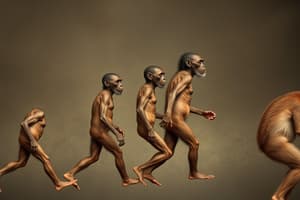Podcast
Questions and Answers
Approximately when did hominids diverge from other primates?
Approximately when did hominids diverge from other primates?
- 2.5 million years ago (correct)
- 1 million years ago
- 6 million years ago
- 4 million years ago
What trait did all hominids share?
What trait did all hominids share?
- Bipedalism (correct)
- Brachiation
- Quadrupedalism
- Arborealism
According to the aridity hypothesis, why did early hominids evolve?
According to the aridity hypothesis, why did early hominids evolve?
- They were more suited to wet climates
- They were more suited to dry climates (correct)
- They were more suited to mountainous regions
- They were more suited to polar regions
When did Homo habilis begin to make and use simple tools?
When did Homo habilis begin to make and use simple tools?
Which hominid species began to migrate out of Africa and into Eurasia?
Which hominid species began to migrate out of Africa and into Eurasia?
What allowed Homo sapiens to make plans, solve problems, and organize effectively?
What allowed Homo sapiens to make plans, solve problems, and organize effectively?
What contributed to the extinction of giant land mammals such as mammoths and mastodons?
What contributed to the extinction of giant land mammals such as mammoths and mastodons?
What limited hunters' available prey?
What limited hunters' available prey?
When did Homo sapiens begin migrating from the African continent and populating parts of Europe and Asia?
When did Homo sapiens begin migrating from the African continent and populating parts of Europe and Asia?
What allowed humans to kill large mammals efficiently?
What allowed humans to kill large mammals efficiently?
What led to the shift from nomadic lifestyles to fixed homes?
What led to the shift from nomadic lifestyles to fixed homes?
What was a widely accepted migration theory for the peopling of North and South America?
What was a widely accepted migration theory for the peopling of North and South America?
What allowed humans to communicate concerns and make plans?
What allowed humans to communicate concerns and make plans?
What limited the hunters' available prey?
What limited the hunters' available prey?
What allowed humans to keep themselves warm in colder climates?
What allowed humans to keep themselves warm in colder climates?
What species began to make other advances like controlling fire?
What species began to make other advances like controlling fire?
Flashcards are hidden until you start studying
Study Notes
Hominid Divergence and Traits
- Hominids diverged from other primates approximately 5-7 million years ago.
- All hominids shared the trait of bipedalism, allowing for upright walking on two legs.
Evolutionary Theories and Tool Use
- According to the aridity hypothesis, early hominids evolved to adapt to changing climates and environments, particularly increased aridity.
- Homo habilis began making and using simple tools around 2.4 million years ago, marking an early phase of technological innovation.
Migration Patterns
- Hominid species such as Homo erectus began migrating out of Africa and into Eurasia approximately 1.9 million years ago.
- Homo sapiens started migrating from Africa around 70,000 years ago, spreading into Europe and Asia.
Cognitive Abilities and Adaptations
- Enhanced cognitive abilities in Homo sapiens, such as advanced problem-solving and planning, were supported by the development of a larger brain.
- The extinction of giant land mammals like mammoths and mastodons was contributed to by human hunting and environmental changes during the last Ice Age.
Hunting and Living Conditions
- The availability of prey was limited by factors such as climate change, habitat loss, and overhunting by early humans.
- Humans developed strategies for efficiently killing large mammals by employing specialized tools and techniques.
Shift to Settled Lifestyles
- The transition from nomadic lifestyles to fixed homes was led by the development of agriculture and stable food sources.
- A widely accepted migration theory for the peopling of North and South America suggests a land bridge known as Beringia connected Asia and North America during the Ice Age.
Communication and Adaptation
- The ability to communicate concerns and make plans was facilitated by the development of complex language and social structures.
- Humans adapted to colder climates through the use of clothing and shelter, enabling them to maintain warmth.
Technological and Social Advances
- Species like Homo erectus were among the first to control fire, leading to significant advances in cooking, warmth, and protection.
Studying That Suits You
Use AI to generate personalized quizzes and flashcards to suit your learning preferences.




